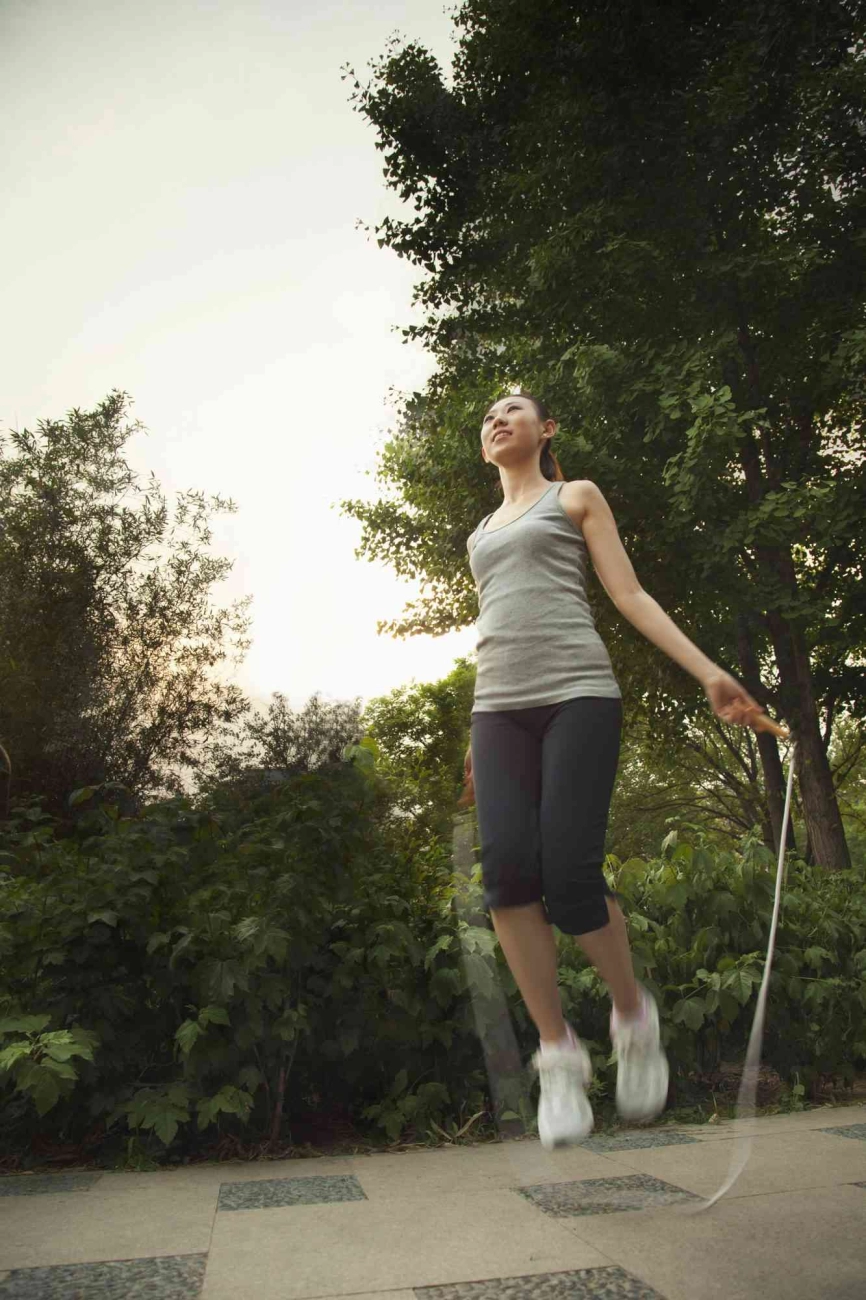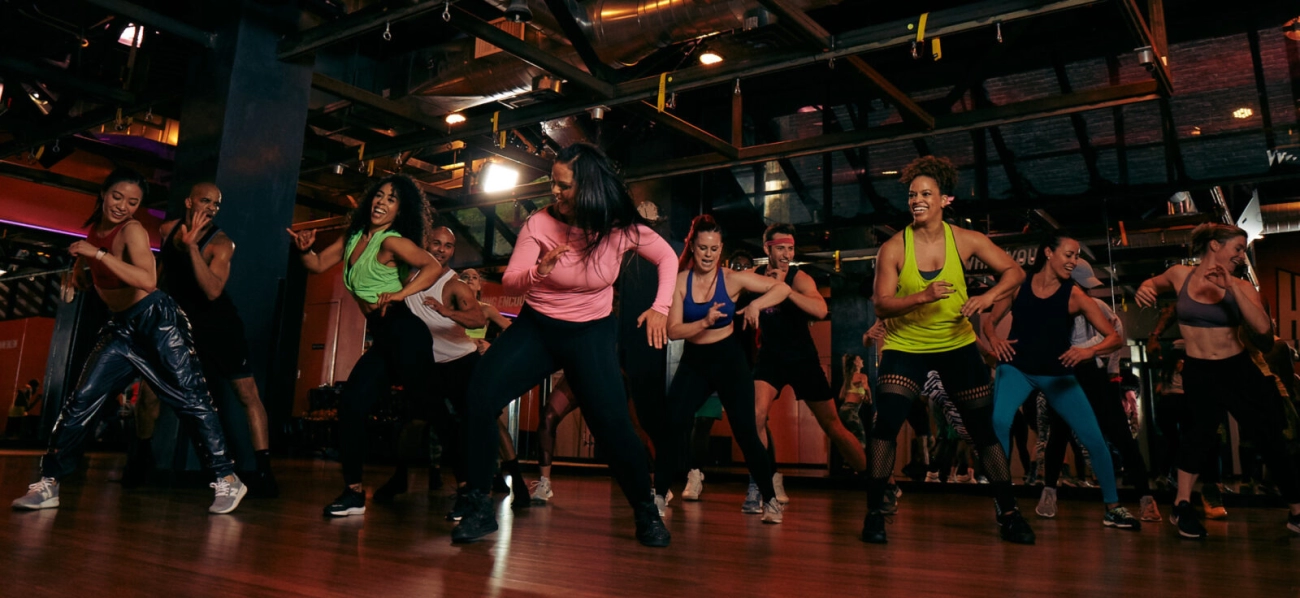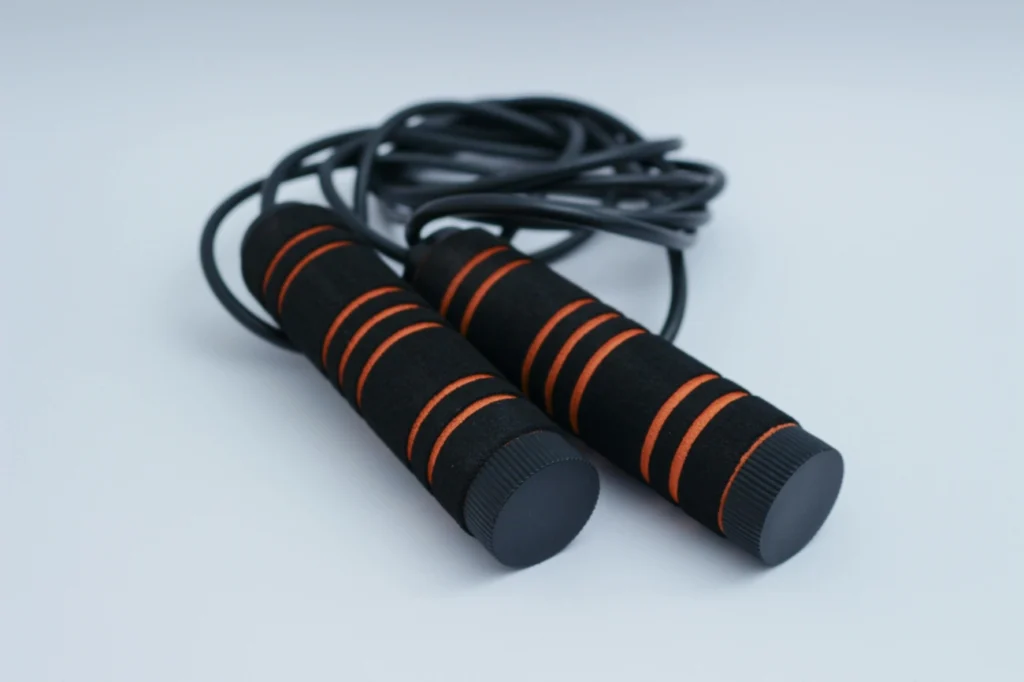Overview of Rope Skipping and Jogging
What is Rope Skipping
Rope skipping, also known as jump rope, is a cardio workout where you rhythmically jump over a rope that’s swung under your feet and over your head in continuous loops. It can be done at a slow, steady pace for endurance or in short, high-intensity bursts for explosive cardio. This exercise can be performed with various rope types, such as PVC jump ropes for speed training or beaded ropes for durability and timing drills. Done correctly, rope skipping engages your entire body—legs, core, shoulders, and even arms—while improving coordination, agility, and cardiovascular fitness.
Basic steps for rope skipping:
- Hold the rope handles at hip height
- Keep elbows close to your body
- Jump on the balls of your feet with a slight bend in the knees
- Maintain a steady rhythm and relaxed shoulders
If you’re looking for high-quality ropes, equipment like the 10mm PVC Jump Rope offers durability and optimal swing speed for both beginners and advanced users.
What is Jogging
Jogging is a steady-paced running exercise that’s typically slower and less intense than sprinting. It’s designed to build endurance, burn calories, and strengthen the cardiovascular system while being less taxing on the body than high-intensity running. Jogging can be done outdoors on tracks, sidewalks, or trails, or indoors on treadmills. It’s accessible, requires minimal equipment, and can be adapted to different fitness levels.
Jogging essentials:
- Maintain an upright posture
- Keep a steady and comfortable pace
- Land softly to reduce joint impact
- Focus on consistent breathing
Historical and Cultural Context
Rope skipping has roots in both play and training. Historically, it appeared as a children’s playground game but evolved into a recognized athletic training tool for boxers, martial artists, and elite athletes because of its agility and speed benefits. It’s now part of competitive sports and fitness routines worldwide.
Jogging, as we know it today, gained mainstream popularity in the 1960s and 70s during the global running boom, largely driven by health awareness campaigns and the influence of distance runners and coaches. It was promoted as a simple, effective way for the average person to improve heart health and longevity.
Both exercises have stood the test of time because they’re affordable, adaptable, and proven to boost physical and mental well-being.
Health and Fitness Benefits Rope Skipping vs Jogging

Cardiovascular Health Improvements
Both rope skipping and jogging are excellent for heart health. They boost circulation, help regulate blood pressure, and improve oxygen delivery throughout the body.
- Rope skipping triggers quick bursts of elevated heart rate, making it a high-intensity cardio workout in less time.
- Jogging builds steady-state endurance with consistent heart rate levels over a longer period.
Impact on Endurance and Stamina
- Rope Skipping: Improves both aerobic and anaerobic capacity; great for sports that require quick bursts of energy.
- Jogging: Builds sustained stamina over time, ideal for long-distance capabilities and overall aerobic endurance.
Muscle Groups Targeted
| Exercise | Main Muscle Groups Worked | Secondary Muscles |
|---|---|---|
| Rope Skipping | Calves, quads, hamstrings, glutes | Core, shoulders, forearms |
| Jogging | Calves, quads, hamstrings, glutes | Core, hip flexors |
Rope skipping engages the upper body more due to the arm rotation, while jogging focuses more heavily on lower-body muscle endurance.
Influence on Bone Density and Joint Health
- Rope Skipping: Higher impact per jump, which helps improve bone density and strengthen joints if done correctly.
- Jogging: Moderate repetitive impact is effective for bone health but carries higher stress on knees over long distances.
- Tip: Proper footwear and technique reduce injury risk for both activities.
Mental Health and Cognitive Benefits
- Rope Skipping: Improves coordination, balance, and quick decision-making, which also enhances brain function.
- Jogging: Supports mood regulation and reduces stress by triggering endorphin release; longer runs often promote a sense of mental clarity.
- Both can help reduce anxiety and depression symptoms when practiced regularly.
Calorie Burn and Weight Loss Potential Rope Skipping vs Jogging
When it comes to burning calories and losing weight, both rope skipping and jogging get the job done, but the numbers tell an interesting story. The burn rate depends on your weight, intensity, and duration—but skipping rope generally delivers a higher burn in less time.
Calories Burned Rope Skipping vs Jogging
On average for a person weighing around 155 lbs (Harvard Medical School data):
| Duration | Rope Skipping (Moderate Pace) | Rope Skipping (Fast Pace) | Jogging (5 mph) | Jogging (6 mph) |
|---|---|---|---|---|
| 10 min | ~125 cal | ~140–150 cal | ~95 cal | ~115 cal |
| 20 min | ~250 cal | ~280–300 cal | ~190 cal | ~230 cal |
| 30 min | ~375 cal | ~420–450 cal | ~285 cal | ~345 cal |
Key Takeaway: Skipping rope can burn 25–40% more calories in the same time compared to steady-paced jogging, especially at higher speeds.
Effectiveness for Weight Loss and Fat Reduction
- Rope Skipping: Short, intense bursts engage more muscle groups at once, which keeps your calorie burn elevated even after you stop (afterburn effect).
- Jogging: Better for maintaining a steady fat-burning heart rate over longer durations. Excellent for people who prefer extended, lower-intensity cardio.
- Both benefit from being paired with a consistent, balanced diet to create a sustainable calorie deficit.
How Intensity and Duration Matter
- High intensity short sessions (like 10–15 minutes of fast rope skipping) can match or exceed the burn of a much longer jog.
- Moderate steady-paced jogs can be easier on endurance and help beginners avoid early fatigue.
- Mixing interval training (e.g., quick 1-minute skipping bursts or jogging sprints) with recovery periods can maximize calorie burn and fat reduction for both methods.
- Frequency is key—3 to 5 sessions per week for either option delivers results over time.
In short: If your goal is maximum calorie burn in minimal time, skipping rope takes the lead. If you prefer a steady and lower-impact fat burn over longer periods, jogging still holds strong.
Impact on Joints and Injury Risk in Rope Skipping vs Jogging

High Impact vs Low Impact Characteristics
Rope skipping and jogging are both weight-bearing, high-impact cardio exercises. This means they both put some stress on the joints — especially the knees, ankles, and hips — which can be beneficial for building bone density but may be tough for those with joint issues.
- Rope skipping creates short, quick impact forces. These are often lower in magnitude than running if done with proper form and on a cushioned surface. The landing is lighter because you stay on the balls of your feet.
- Jogging produces repetitive, longer contact impact. The stress per step is usually higher, especially when running outdoors on concrete or asphalt.
Common Injuries in Rope Skipping
Frequent issues with rope skipping often include:
- Shin splints from overuse or poor landing technique.
- Ankle sprains from poor coordination or uneven surfaces.
- Calf strain if skipping intensity ramps up too quickly.
Common Injuries in Jogging
Jogging injuries tend to be linked to repetitive strain:
- Runner’s knee (patellofemoral pain) caused by repeated knee stress.
- Plantar fasciitis from stress on the foot arch.
- IT band syndrome from hip and knee misalignment.
Suitability for Beginners, Older Adults, and People with Joint Concerns
- For beginners: Rope skipping can be introduced in short bursts (30–60 seconds) with plenty of rest. Jogging should start slow on soft surfaces (track, turf, treadmill).
- For older adults: Jogging on grass or treadmill is generally lower risk than skipping, unless they already have good balance and coordination.
- For people with joint pain: Low-impact alternatives like cycling, swimming, or elliptical are safer. However, if cleared by a doctor, rope skipping on foam flooring and with shorter sessions might still work.
Pro Tip:
Whichever you choose, focus on:
- Supportive footwear with cushioning.
- Gradual progression of intensity.
- Strength training for legs and core to protect joints.
Convenience and Practicality Rope Skipping vs Jogging
Space and Equipment Needs
- Rope skipping requires very little space — a clear area of about 4–6 feet in diameter works for most people. The only equipment needed is a quality jump rope and supportive shoes.
- Jogging needs more open space, such as sidewalks, tracks, or trails. You’ll mainly need good running shoes but no other gear unless you track distance or pace.
Indoor vs Outdoor Suitability
- Rope skipping can be done indoors or outdoors, making it a year-round option. Indoor skipping works well in garages, basements, or home gyms, which is a big plus in areas with harsh winters or rainy seasons.
- Jogging is mainly an outdoor workout, though treadmill running indoors offers an alternative. Outdoor running provides fresh air and changing scenery, but weather can limit your consistency.
Time Efficiency and Portability
- Rope skipping is one of the most portable workouts—you can throw a jump rope into a gym bag, suitcase, or desk drawer. Even short sessions (5–10 minutes) can deliver a solid cardio boost.
- Jogging generally requires more time to warm up, get into pace, and return home unless you’re using a treadmill at home or the gym. It’s less portable compared to a jump rope.
Weather and Seasonal Considerations
- Rope skipping doesn’t depend on perfect weather, making it great for people in the U.S. with hot summers, icy winters, or unpredictable rain.
- Outdoor jogging is heavily influenced by conditions—heat waves, snow, or icy sidewalks can make it unsafe. Many runners switch to treadmills in the winter, which can require a gym membership or home equipment investment.
Cost and Accessibility of Rope Skipping vs Jogging
Cost of Rope Skipping
Rope skipping is one of the most budget-friendly cardio workouts you can do. All you really need is a quality jump rope—a durable PVC, beaded, or adjustable rope can range from $10 to $30 depending on the material and features. Higher-end ropes with ball bearings or weighted handles might cost more, but even then, the investment is minimal compared to other fitness gear. There are no ongoing fees, and you can use the same rope for years if maintained properly.
Key points:
- One-time purchase, low overall cost
- Minimal maintenance needed
- Works indoors or outdoors without extra gear
Cost of Jogging
Jogging might seem “free,” but there are still essential costs. A good pair of running shoes is a must to prevent injury, and these can range from $80 to $150 depending on the brand and support level. If you choose to run on a treadmill at a gym, factor in gym memberships—averaging $30–$60 per month in most U.S. cities. Some city parks may charge entry or parking fees, but in many suburban or rural areas, open road jogging remains free.
Key points:
- Initial investment in running shoes
- Possible recurring costs for gym access or park passes
- Shoes need replacing every 300–500 miles
Urban vs Rural Accessibility
Rope skipping is easy to do anywhere—urban apartments, basements, garages, or driveways. It doesn’t require a running path, track, or large space, making it ideal in congested city neighborhoods or during bad weather. On the other hand, jogging requires safe, open areas to run, which can be challenging in high-traffic urban zones unless you have access to parks or a treadmill. In rural areas, jogging can be more accessible with open roads, but weather conditions and distance from safe paths can still be factors.
Accessibility breakdown:
- Urban areas: Rope skipping is easier to fit into small spaces; jogging may require access to parks or gyms.
- Rural areas: Jogging is often more feasible outdoors; rope skipping remains an option regardless of location.
- Weather flexibility: Rope skipping wins for year-round indoor use; jogging may be limited by heat, snow, or rain.
Motivation and Enjoyment Factors Rope Skipping vs Jogging
Social and Psychological Aspects of Jogging
Jogging often appeals to people who like a social and outdoor experience. Many runners join local running clubs or meetups, which can boost motivation and accountability. Running with others can make workouts feel easier and more enjoyable because of the shared energy and encouragement.
- Scenic routes can make jogging a more mindful, stress-reducing activity. Parks, trails, and waterfronts provide a refreshing change from indoor workouts.
- Regular interaction with other runners helps create a sense of community, which plays a big role in sticking to a fitness routine over time.
- Outdoor exposure also supports mental well-being by improving mood and lowering feelings of anxiety.
Fun Factor and Variety in Rope Skipping
Rope skipping offers a completely different kind of enjoyment — one that blends skill, rhythm, and creativity. You can skip solo at home or in the gym while mixing up workouts to avoid boredom.
- Learn and practice skipping variations like double unders, criss-cross, and side swings to challenge yourself.
- Sync routines to music for an energizing, dance-like workout that keeps you engaged.
- Changing rope types (PVC, beaded, speed ropes) and adjusting speed helps keep sessions fresh.
How Enjoyment Affects Long Term Commitment
Whether it’s the social connection in jogging or the playful challenge in rope skipping, enjoyment is directly tied to commitment.
- People tend to stick with an exercise they look forward to, rather than one that feels like a chore.
- Rope skipping’s quick learning curve for beginners makes it instantly rewarding, while jogging offers a steady, calming rhythm perfect for those who enjoy longer, meditative workouts.
- Both activities trigger endorphin release, which boosts mood and strengthens the habit loop, making it easier to stay consistent in the long run.
Which Exercise is Best for Your Goal

When comparing rope skipping vs jogging, the right choice depends on what you’re aiming to achieve. Both are great cardio options, but they serve different purposes depending on your fitness goals, current ability, and available time.
Best Choice for Weight Loss
If your main focus is burning calories fast, rope skipping comes out on top. Studies show that a 150-pound person can burn roughly 200–300 calories in just 15 minutes of jump rope at a moderate pace—similar to running at an 8-minute mile pace. The higher calorie burn in a short timeframe makes it perfect if you want quick calorie deficits for weight loss.
- Rope skipping: High-calorie burn, intense full-body workout, great for shredding fat faster.
- Jogging: Lower calorie burn per minute but easier to sustain over long durations, making it good for those who enjoy steady-state fat burning.
Best for Cardiovascular Endurance
For long-term aerobic capacity improvement, jogging takes the win. Maintaining a steady pace for extended periods builds endurance gradually without the fatigue spikes rope skipping can cause. Distance runners, soccer players, and other endurance athletes often stick with jogging for this reason.
- Jogging: Better for building a strong, sustained cardiovascular base.
- Rope skipping: Improves cardiovascular health but is more anaerobic—great for bursts rather than long sessions.
Best for Beginners vs Advanced Users
- Beginners: Jogging is more forgiving. You can start slow, use natural pacing, and improve over time. Jump rope requires timing and coordination, which might be tricky at first.
- Advanced users: Rope skipping offers variety (double-unders, crossovers, HIIT intervals) and higher intensity for those already conditioned.
Best for Improving Coordination and Agility
Rope skipping wins hands down for coordination, balance, and agility. The constant rhythm, footwork changes, and upper-lower body synchronization train your nervous system in ways jogging cannot. That’s why boxers, fighters, and athletes in agility-based sports regularly use jump rope drills.
Best for Time Restricted Fitness Routines
If you’re short on time, go with rope skipping. You can hit the same calorie burn and cardio benefits in 10–15 minutes that might take 30 minutes of jogging. It’s easy to fit into a lunch break or morning routine without leaving home.
Quick reference guide:
| Goal | Rope Skipping | Jogging |
|---|---|---|
| Fast Weight Loss | ✅ High calorie burn in short time | Good for long sessions |
| Cardio Endurance | Good but more intense | ✅ Best for steady build |
| Beginners | Learning curve | ✅ Easy start |
| Agility/Coordination | ✅ Excellent | Minimal |
| Time Efficiency | ✅ Best option | Requires longer sessions |
How to Incorporate Rope Skipping and Jogging Into Your Fitness Routine
Adding rope skipping and jogging into your workout plan can be simple and effective if you follow a clear structure. Both exercises can be used alone or together for a balanced cardio plan that builds endurance, burns calories, and improves coordination.
Sample Weekly Workout Plans
Beginner Plan (3–4 days per week)
- Day 1: 5 minutes rope skipping (slow pace) + 15 minutes light jogging
- Day 2: Rest or light strength training
- Day 3: 7–10 minutes rope skipping (alternate feet) + bodyweight exercises
- Day 4: 20 minutes jogging (easy pace)
Intermediate Plan (4–5 days per week)
- Day 1: 2 minutes rope skipping + 2 minutes jogging (alternate for 20 minutes)
- Day 2: 25 minutes steady jogging
- Day 3: Rope skipping intervals — 30 seconds fast, 30 seconds slow for 15 minutes
- Day 4: Rest or mobility work
- Day 5: 20 minutes jogging + 5–7 minutes rope skipping finisher
Advanced Plan (5–6 days per week)
- Day 1: 10 minutes rope skipping warm-up + 30-minute run (moderate to hard pace)
- Day 2: Rope skipping HIIT — 40 seconds fast, 20 seconds rest x 20 sets
- Day 3: Long jogging session — 45–60 minutes
- Day 4: Rope skipping skill work (crossovers, double-unders) for 15 minutes
- Day 5: Jogging sprints — 30 seconds sprint, 90 seconds walk x 10 rounds
- Day 6: Light rope skipping recovery — 5 minutes slow pace
Tips for Beginners to Avoid Injury
- Start slow: Begin with short bursts and build up as your stamina grows.
- Use proper shoes: Good cushioning helps protect your joints.
- Pick the right rope: Adjustable ropes (like premium beaded or PVC options) improve control.
- Warm up and cool down: Loosen muscles before, and stretch after.
- Mix surfaces: Jog on softer surfaces (track, grass) when possible to reduce joint stress.
Fitness Expert Recommendations
- Alternate workouts: Combining both exercises avoids monotony and trains different muscle groups.
- Focus on form: Slight bend in knees when skipping, steady rhythm when jogging.
- Vary intensity: High-intensity skipping burns more calories in less time, while longer jogs build endurance.
- Listen to your body: Take rest days to avoid overuse injuries.
- Track progress: Use a fitness watch or app to measure improvements in speed, endurance, or jump count.
Why Choose JumpRopeManufacturer for Your Rope Skipping Needs
Trusted Jump Rope Supplier in the USA
At JumpRopeManufacturer, we’ve built our reputation as a reliable supplier of high-quality jump ropes used by fitness enthusiasts, athletes, and beginners across the United States. We focus on making ropes that are durable, comfortable, and effective—because the right gear can make all the difference in your workouts.
Our Unique Selling Points
We know U.S. customers value quality, innovation, and performance, so every product we make is crafted with that in mind:
| Feature | What You Get | Why It Matters |
|---|---|---|
| Premium Materials | PVC, beaded, and adjustable ropes | Long-lasting and withstand daily use indoors or outdoors |
| Adjustable Lengths | Fits kids, teens, and adults | No need to buy multiple ropes for different users |
| Custom Options OEM/ODM | Build to your style or brand | Perfect for gyms, sports teams, and retail |
| Smooth Rotation Design | No tangling, consistent speed | Better workout flow, less frustration |
| Comfort Grip Handles | Sweat-resistant, ergonomic design | Keeps hands comfortable during longer sessions |
Helping You Maximize Rope Skipping Benefits
We design our ropes to match your fitness goals, whether it’s weight loss, cardio endurance, agility training, or at-home workouts. By offering lightweight, portable, and easy-to-store ropes, we make it easy to train anywhere—whether you’re indoors during winter or outside in the park.
Why US Customers Choose Us
- Fitness versatility: Great for HIIT, fat burning, coordination drills, and warm-ups.
- Durability for daily use: Tested to hold up on gym floors, driveways, and sports courts.
- Beginner to pro friendly: From adjustable beaded ropes for learning to speed ropes for advanced workouts.
- Quick shipping within the US: Get your rope fast so you can start training right away.
Start Your Fitness Journey Today
The sooner you have the right rope, the sooner you can start seeing results. Browse our selection of jump ropes—from adjustable PVC to professional-grade beaded styles—and find the one that fits your lifestyle. Your best workouts start with the right equipment.



